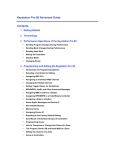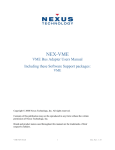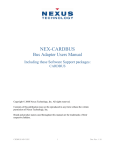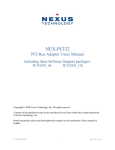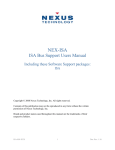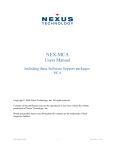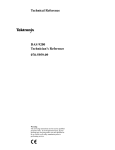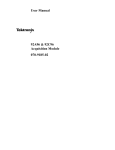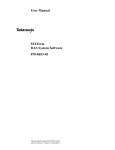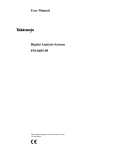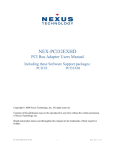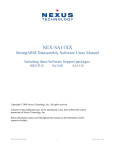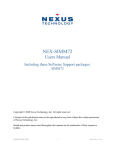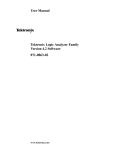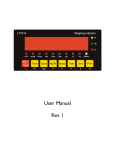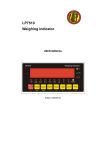Download NEX-PCMCIA Manual
Transcript
NEX-PCMCIA PCMCIA Bus Adapter Users Manual Including these Software Support packages: PCMCIA Copyright © 2008 Nexus Technology, Inc. All rights reserved. Contents of this publication may not be reproduced in any form without the written permission of Nexus Technology, Inc. Brand and product names used throughout this manual are the trademarks of their respective holders. PCMCIA-MN-XXX 1 Doc. Rev. 1.10 Warranty Terms and License Agreement For warranty terms, refer to the Terms and Conditions of Sale document that was included in the product shipment. The Software License Agreement is displayed during installation. A hardcopy of that agreement may be obtained from Nexus Technology. All Nexus Technology products to which this manual refers are subject to the Terms and Conditions of Sale document and the Software License Agreement, as appropriate. Compliance with WEEE and RoHS Directives This product is subject to European Union regulations on Waste Electrical and Electronics Equipment. Return to Nexus Technology for recycle at end of life. Costs associated with the return to Nexus Technology are the responsibility of the sender. PCMCIA-MN-XXX 2 Doc. Rev. 1.10 TABLE OF CONTENTS 1.0 OVERVIEW ........................................................................................................................... 4 1.1 General Information............................................................................................................ 4 2.0 SOFTWARE INSTALLATION ............................................................................................. 4 2.1 TLA600/700........................................................................................................................ 4 2.2 DAS 9200............................................................................................................................ 5 3.0 CONFIGURING the NEX-PCMCIA BUS ADAPTER ......................................................... 5 4.0 CONNECTING to the NEX-PCMCIA ADAPTER ............................................................... 5 4.1 General................................................................................................................................ 5 4.2 92A96.................................................................................................................................. 5 4.3 TLA600/700........................................................................................................................ 6 4.4 Inserting / Removing PCMCIA DUT Cards....................................................................... 6 5.0 CLOCK SELECTION and VIEWING DATA....................................................................... 8 5.1 General Information............................................................................................................ 8 5.2 Viewing State Data with the DAS 9200 ............................................................................. 8 5.3 Viewing State Data with the TLA600/700 ......................................................................... 9 5.4 Viewing Timing Data with the DAS 9200 ......................................................................... 9 5.5 Viewing Timing Data with the TLA600/700...................................................................... 9 APPENDIX A - Necessary Signals for Clocking ......................................................................... 11 APPENDIX B - Considerations.................................................................................................... 12 B.1 PCMCIA Loading ............................................................................................................ 12 B.2 Pattern Generation............................................................................................................ 12 B.3 3.3V Support .................................................................................................................... 12 B.4 Inserting / Removing PCMCIA DUT Cards .................................................................... 12 APPENDIX C - PCMCIA Pinout ................................................................................................. 13 APPENDIX D - NEX-PCMCIA Silk Screen ............................................................................... 15 APPENDIX E - Support ............................................................................................................... 16 APPENDIX F - References .......................................................................................................... 17 TABLE OF TABLES Table 1- PCMCIA 92A96 / TLA600/700 Wiring........................................................................... 7 Table 2- PCMCIA Control Symbol Table ...................................................................................... 8 Table 3- PCMCIA Memory Only Card Interface ......................................................................... 13 Table 4- PCMCIA I/O and Memory Card Interface..................................................................... 14 PCMCIA-MN-XXX 3 Doc. Rev. 1.10 1.0 OVERVIEW 1.1 General Information The NEX-PCMCIA adapter has been designed to provide quick and easy connections to interface a 68, 102, or 136 channel TLA600/700, a 92A96 or 92C96 acquisition module to a PCMCIA card slot. (The PCMCIA designation refers to the Personal Computer Memory Card Internal Association specification.) In addition, the method of connection permits the use of other acquisition cards (such as the 92HS8 2GHz high-speed module), pattern generation cards (such as the 92S32 50MHz Pattern Generator) or other measurement devices such as oscilloscopes. This manual assumes that the user is aware that the 92A96 and 92C96 modules from Tektronix are essentially identical. This manual therefore refers to the 92A96 but the 92C96 could be substituted in all cases. References to the TLA700 also apply to TLA600 and a TLA700 with a TLA704 or TLA711 chassis with one or more 7L2/3/4 or 7M2/3/4 acquisition cards. Appendix D is a silk-screen print of the NEX-PCMCIA Adapter board. Referring to this drawing while reading the manual is suggested. This manual assumes that the user is familiar with the PCMCIA Bus specification and the Tektronix DAS 9200 or TLA600/700 Logic Analyzer. Also in the case of the TLA600/700, it is expected that the user is familiar with Windows 95. 2.0 SOFTWARE INSTALLATION Two 3½” diskettes have been included with the NEX-PCMCIA Bus Adapter. One is for use with the TLA600/700 series, the other is to be used with a DAS9200 or TLA500. 2.1 TLA600/700 The PCMCIA support software is loaded in the same method as other Win95 programs. Place the NEX-PCMCIA Install disk in the floppy drive of the TLA600/700. Select Control Panel and run Add/Remove Programs, choose Install, Next, then Finish. Add/Remove will then run SETUP.EXE on the floppy and install the support in its proper place on the hard disk. To load a support into the TLA600/700, first select the desired Logic Analyzer card in the Setup screen, select Load Support Package from the File pull-down, then choose PCMCIA and click on Okay. Note that the Logic Analyzer card must be at least 68-channels in width. PCMCIA-MN-XXX 4 Doc. Rev. 1.10 2.2 DAS 9200 The included diskette should be loaded onto the DAS 9200 using the Install Application function. This function is available from the Disk Services menu of the DAS. For more information, refer to the Tektronix DAS 9200 System User's Manual. Load the desired support from within the 92A96 Config menu. Select "PCMCIA Support", press <RETURN>, and the channel grouping, clocking and symbols will then be loaded. 3.0 CONFIGURING the NEX-PCMCIA BUS ADAPTER The NEX-PCMCIA adapter is longer than a standard PCMCIA module, and is designed to function both as signal break-out board and as an extender card. An external connector is available to supply power to the DUT (Device Under Test) that is separate from the power supplied by the target system. To use this feature simply wire the external power supply to the VPP1, VPP2, VCC, and GND connections on the terminal block. To power the DUT from external power move the jumpers at JP1, JP2, and JP3 from their default SYS setting (the lower two pins) to the EXT setting (the upper pair of pins). 4.0 CONNECTING to the NEX-PCMCIA ADAPTER 4.1 General When using either the 92A96 or TLA600/700, sections D2 and D3 are available for acquiring any other signals of interest. By default the groups containing these sections (Aux_A and Aux_B respectively) are not displayed, but they may be enabled at any time. These signals need not be on the NEX-PCMCIA card but may be signals located on the DUT or on the controlling system. Signals on these sections (D2 and D3) will be acquired and stored at the end of the PCMCIA bus cycle. 4.2 92A96 When using a 92A96, connect the grouped pods (8 podlets to a group) to their appropriate locations by following the silk-screen information printed on the adapter board. The 92A96 pods used are A0-A3, D0, D1, C0 and C2. Each pod has its proper location denoted on the silkscreen of the adapter board. When attaching the pods, follow the silk-screen information on the board showing the ground and signal pin locations. The colored sides of the podlets, the signal side, should face either the center of the adapter board or the board end that plugs into the host system. Connect the three clock leads (CLK0, CLK1, and CLK2) to their specified locations at J13 (the only connector with 4 locations). Again, follow the silk-screened information to properly PCMCIA-MN-XXX 5 Doc. Rev. 1.10 connect the clock input and its ground. Table 1 shows the wiring and Channel Grouping for the 92A96 when used with PCMCIA Support. 4.3 TLA600/700 The TLA600/700 will be connected in the same method as an A96. However, it's important to note that signal group C3 is used in place of A96 group C0. Table 1 shows the Channel Grouping and wiring for the TLA600/700 when used with PCMCIA Support. 4.4 Inserting / Removing PCMCIA DUT Cards It is recommended that the NEX-PCMCIA adapter board be connected to the target system prior to inserting a PCMCIA DUT. Because the NEX-PCMCIA card does not have the mechanical guides typically found in PCMCIA designs, it is recommended that care be taken to insert and remove the DUT as smoothly as possible. When used in this fashion and when the DUT is powered from the target system (power jumpers in the SYS position) the power LEDs will not be on until a DUT is installed in the NEX-PCMCIA adapter. PCMCIA-MN-XXX 6 Doc. Rev. 1.10 Group Name Address (HEX) Control (SYM) Signal Name A25 A24 A23 A22 A21 A20 A19 A18 A17 A16 A15 A14 A13 A12 A11 A10 A9 A8 A7 A6 A5 A4 A3 A2 A1 A0 WP/IO16~ WE~/PGM~ OE~ IORD~ IOWR~ RESET WAIT~ PCMCIA Pin # 56 55 54 53 50 49 48 47 46 19 20 14 13 21 10 8 11 12 22 23 24 25 26 27 28 29 33 15 9 44 45 58 59 92A96 input A3:1 A3:0 A2:7 A2:6 A2:5 A2:4 A2:3 A2:2 A2:1 A2:0 A1:7 A1:6 A1:5 A1:4 A1:3 A1:2 A1:1 A1:0 A0:7 A0:6 A0:5 A0:4 A0:3 A0:2 A0:1 A0:0 C2:0 C2:5 C2:4 C2:6 C2:7 C2:2 C2:3 TLA700 input A3:1 A3:0 A2:7 A2:6 A2:5 A2:4 A2:3 A2:2 A2:1 A2:0 A1:7 A1:6 A1:5 A1:4 A1:3 A1:2 A1:1 A1:0 A0:7 A0:6 A0:5 A0:4 A0:3 A0:2 A0:1 A0:0 C2:0 C2:5 C2:4 C2:6 C2:7 C2:2 C2:3 Group Name Data (HEX) Misc (OFF) Clock:0 Clock:1 Clock:2 Clock:3 Signal Name D15 D14 D13 D12 D11 D10 D9 D8 D7 D6 D5 D4 D3 D2 D1 D0 D_CLK RFU57 SPKR STSCHG RFSH REG~ CD2~ CD1~ CE2~ CE1~ INPACK~ PCMCIA Pin # 41 40 39 38 37 66 65 64 6 5 4 3 2 33 31 30 * 57 62 63 43 61 67 36 42 7 60 D_CLK IORD~ RFSH * 44 43 92A96 input D1:7 D1:6 D1:5 D1:4 D1:3 D1:2 D1:1 D1:0 D0:7 D0:6 D0:5 D0:4 D0:3 D0:2 D0:1 D0:0 C0:4 C0:3 C0:1 C0:0 C0:2 A3:3 A3:7 A3:6 A3:5 A3:4 A3:2 TLA700 input D1:7 D1:6 D1:5 D1:4 D1:3 D1:2 D1:1 D1:0 D0:7 D0:6 D0:5 D0:4 D0:3 D0:2 D0:1 D0:0 --C3:3 C3:1 C3:0 C3:2 A3:3 A3:7 A3:6 A3:5 A3:4 A3:2 Table 1- PCMCIA 92A96 / TLA600/700 Wiring * Derived signal ~ Denotes a low true signal PCMCIA-MN-XXX 7 Doc. Rev. 1.10 Pattern xxxxx1x 0xx010x 0xx100x 1xx010x 1xx100x 110110x 101110x xxxxxx0 Symbol RESET I/O RD16 I/O WR16 I/O RD8 I/O WR8 MEM RD MEM WRT WAIT Meaning Reset 16-bit I/O Read 16-bit I/O Write 8-bit I/O Read 8-bit I/O Write Memory Read Memory Write Wait Cycle Table 2- PCMCIA Control Symbol Table Signals, from left to right:WP/IO16~, WE~/PGM~, OE~, IORD~, IOWR~, RESET, WAIT~ 5.0 CLOCK SELECTION and VIEWING DATA 5.1 General Information All PCMCIA data is usually acquired on the rising edge of IORD~, IOWR~, OE~, or WE~/PGM~. The only difference is when IORD~ is active - certain control lines are stored on the falling edge of IORD~ to ensure proper acquisition. For proper PCMCIA cycle acquisition these signals must be present. 5.2 Viewing State Data with the DAS 9200 After an acquisition is made the DAS 9200 Logic Analyzer will display the data in State Display mode (as a default only). Address and Data information is displayed in hexadecimal format; Control data is displayed using symbols; Miscellaneous and both Auxiliary data groups default to OFF. The use of Symbol Tables when displaying state data enables the user to quickly determine what type of bus cycle was acquired. One symbol table (Table 4) has been provided to show the type of transaction that occurred on the PCMCIA bus, and its DAS filename is "PCMCIA_Ctrl". This symbol table quickly shows whether the acquisition was a memory or I/O operation, whether it was a read or a write, etc. PCMCIA-MN-XXX 8 Doc. Rev. 1.10 It is important to note that changing the group, channel, or wiring of the Control group can result in incorrect symbol information being displayed. 5.3 Viewing State Data with the TLA600/700 After making an initial acquisition, the TLA600/700 will display the data in the Listing (State) format. Address and Data information is displayed in hexadecimal format; Transfer, Mode, and Misc data is displayed using symbols; Interrupts (Intrpts) and Bus Master (BusMstr) data groups default to Hexadecimal. The use of Symbol Tables when displaying state data enables the user to quickly determine what type of bus cycle was acquired. When using NEX-PCMCIA, a symbol table (PCMCIA_CTRL) has been provided to show the type of transfer that occurred on the PCMCIA bus. PCMCIA_CTRL has the same definition as the symbol table used in the DAS (see Table 4). Again, it must be noted that changing the group, channel, or wiring of the Control group can result in incorrect symbol information being displayed. 5.4 Viewing Timing Data with the DAS 9200 It may be useful to display acquired information using the Timing Diagram display of the DAS 9200. (Note that, unlike some other logic analyzers, with the DAS 9200 there is no need to reacquire PCMCIA data when changing from one display mode to another. The same data can be viewed in either format.) This method of data display can be particularly useful when an asynchronous acquisition has been made (using the DAS 9200 internal acquisition clock) to determine the relationships between signal edges. The 92A96 is particularly well suited for this mode of operation because of its ability to acquire data asynchronously at a 400MHz rate, providing 2.5ns of timing resolution. Refer to the appropriate Tektronix DAS 92A96 Module User's Manual for more detailed information on formatting the display of the acquired data. 5.5 Viewing Timing Data with the TLA600/700 By default, the TLA600/700 will display an acquisition in the Listing (State) mode. However, the same data can be displayed in Timing form by adding a Waveform Display window. This is done by clicking on the Window pull-down, selecting New Data Window, clicking on Waveform Window Type, then choosing the Data Source. Two choices are presented: PCMCIA and PCMCIA-MagniVu. The first (PCMCIA) will show the exact same data (same acquisition mode) as that shown in the Listing window, except in Timing format. The second selection, PCMCIA-MagniVu, will show all of the channels in 2GHz MagniVu mode, so that edge relationships can be examined at the module’s trigger point. With either selection, all PCMCIA-MN-XXX 9 Doc. Rev. 1.10 channels can be viewed by scrolling down the window. Refer to the TLA600/700 System User’s Manual for additional information on formatting the Waveform display. Like all Tektronix logic analyzers, the acquired data can be viewed in Timing format as well as State format, without having to make another acquisition. Simply select "Timing" in the display section of the Prism. PCMCIA-MN-XXX 10 Doc. Rev. 1.10 APPENDIX A - Necessary Signals for Clocking To properly acquire PCMCIA bus activity, the following signals must be provided: IORD~, IOWR~, OE~, and WE~/PGM~. With the exception of IORD~ the rising edge of these signals is used as the active clocking edge. When IORD~ is active both edges are used to acquire data. PCMCIA-MN-XXX 11 Doc. Rev. 1.10 APPENDIX B - Considerations B.1 PCMCIA Loading It must be noted that the NEX-PCMCIA Bus Adapter does not provide any buffering of the PCMCIA bus signals. This was a conscious design decision that was made by balancing the tradeoffs of loading versus design simplicity and signal acquisition accuracy. By not introducing signal buffers it is possible, using the NEX-PCMCIA adapter, to see the exact timing relationships and signal waveforms from the system. It is also much easier to connect pattern generators to the bus since buffer direction is not a concern. It is believed that the signal loading of the 92A96 or TLA600/700 acquisition cards is low enough so that PCMCIA signal degradation will not occur. B.2 Pattern Generation Because there is no buffer circuitry on the NEX-PCMCIA Adapter, it is well suited for use with the 92S16 and 92S32 Pattern Generator modules available for the DAS 9200. By connecting pattern generator probes to the A96 signal connectors on the Adapter, desired bus activity can be simulated. This can be particularly effective when trying to debug interrupt or DMA conflicts. It should be noted that, because of the pin spacing of the A96 connectors, it is not recommended that the Tektronix P6464 or P6465 pattern generator probes be used without providing adequate cooling for their podlets. These probes use active podlets that can get very warm in use. A better choice would be the P6463 pods which are passive and do not have such cooling requirements. B.3 3.3V Support For support of 3.3V PCMCIA cards please contact Nexus Technology, Inc. for upgrade information. B.4 Inserting / Removing PCMCIA DUT Cards It is recommended that the NEX-PCMCIA adapter board be connected to the target system prior to inserting a PCMCIA DUT. Because the NEX-PCMCIA card does not have the mechanical guides typically found in PCMCIA designs, it is recommended that care be taken to insert and remove the DUT as smoothly as possible. When used in this fashion and when the DUT is powered from the target system (power jumpers in the SYS position) the power LEDs will not be on until a DUT is installed in the NEX-PCMCIA adapter. PCMCIA-MN-XXX 12 Doc. Rev. 1.10 APPENDIX C - PCMCIA Pinout Pin 1 2 3 4 5 6 7 8 9 10 11 12 13 14 15 16 17 18 Signal GND D3 D4 D5 D6 D7 CE1~ A10 OE~ A11 A9 A8 A13 A14 WE~/PGM~ RDY/BSY Vcc Vpp1 Function Ground Data bit 3 Data bit 4 Data bit 5 Data bit 6 Data bit 7 Card enable 1 Address bit 10 Output enable Address bit 11 Address bit 9 Address bit 8 Address bit 13 Address bit 14 Write enable Ready/Busy Pin 35 36 37 38 39 40 41 42 43 44 45 46 47 48 49 50 51 52 Signal GND CD1~ D11 D12 D13 D14 D15 CE2~ RFSH RFU RFU A17 A18 A19 A20 A21 Vcc Vpp2 19 20 21 22 23 24 25 A16 A15 A12 A7 A6 A5 A4 Programming Supply Voltage 1 Address bit 16 Address bit 15 Address bit 12 Address bit 7 Address bit 6 Address bit 5 Address bit 4 53 54 55 56 57 58 59 A22 A23 A24 A25 RFU RESET WAIT~ 26 27 28 A3 A2 A1 Address bit 3 Address bit 2 Address bit 1 60 61 62 RFU REG~ BVD2 29 A0 Address bit 0 63 BVD1 30 31 32 33 34 D0 D1 D2 WP GND Data bit 0 Data bit 1 Data bit 2 Write protect Ground 64 65 66 67 68 D8 D9 D10 CD2~ GND Function Ground Card detect 1 Data bit 11 Data bit 12 Data bit 13 Data bit 14 Data bit 15 Card enable 2 Refresh Reserved Reserved Address bit 17 Address bit 18 Address bit 19 Address bit 20 Address bit 21 Programming Supply Voltage 2 Address bit 22 Address bit 23 Address bit 24 Address bit 25 Reserved Card Reset Extend bus cycle Reserved Register select Battery voltage detect 2 Battery voltage detect 1 Data bit 8 Data bit 9 Data bit 10 Card detect 2 Ground Table 3- PCMCIA Memory Only Card Interface PCMCIA-MN-XXX 13 Doc. Rev. 1.10 Pin 1 2 3 4 5 6 7 8 9 10 11 12 13 14 15 16 17 18 Signal GND D3 D4 D5 D6 D7 CE1~ A10 OE~ A11 A9 A8 A13 A14 WE~/PGM~ IREQ~ Vcc Vpp1 Function Ground Data bit 3 Data bit 4 Data bit 5 Data bit 6 Data bit 7 Card enable 1 Address bit 10 Output enable Address bit 11 Address bit 9 Address bit 8 Address bit 13 Address bit 14 Write enable Interrupt Request Pin 35 36 37 38 39 40 41 42 43 44 45 46 47 48 49 50 51 52 Signal GND CD1~ D11 D12 D13 D14 D15 CE2~ RFSH IORD~ IOWR~ A17 A18 A19 A20 A21 Vcc Vpp2 19 20 21 22 23 24 25 26 A16 A15 A12 A7 A6 A5 A4 A3 Programming Supply Voltage 1 Address bit 16 Address bit 15 Address bit 12 Address bit 7 Address bit 6 Address bit 5 Address bit 4 Address bit 3 53 54 55 56 57 58 59 60 A22 A23 A24 A25 RFU RESET WAIT~ INPACK~ 27 A2 Address bit 2 61 REG~ 28 A1 Address bit 1 62 SPKR~ 29 A0 Address bit 0 63 STSCHG~ 30 31 32 33 34 D0 D1 D2 IOIS16~ GND Data bit 0 Data bit 1 Data bit 2 IO Port is 16-bit Ground 64 65 66 67 68 D8 D9 D10 CD2~ GND Function Ground Card detect 1 Data bit 11 Data bit 12 Data bit 13 Data bit 14 Data bit 15 Card enable 2 Refresh IO Read IO Write Address bit 17 Address bit 18 Address bit 19 Address bit 20 Address bit 21 Programming Supply Voltage 2 Address bit 22 Address bit 23 Address bit 24 Address bit 25 Reserved Card Reset Extend bus cycle Input Port Acknowledge Register select & IO Enable Audio Digital Waveform Card Status Changed Data bit 8 Data bit 9 Data bit 10 Card detect 2 Ground Table 4- PCMCIA I/O and Memory Card Interface PCMCIA-MN-XXX 14 Doc. Rev. 1.10 APPENDIX D - NEX-PCMCIA Silk Screen PCMCIA-MN-XXX 15 Doc. Rev. 1.10 APPENDIX E - Support About Nexus Technology, Inc. Established in 1991, Nexus Technology, Inc. is dedicated to developing, marketing, and supporting Bus Analysis applications for Tektronix Logic Analyzers. We can be reached at: Nexus Technology, Inc. 78 Northeastern Blvd. #2 Nashua, NH 03062 TEL: 877-595-8116 FAX: 877-595-8118 Web site: http://www.nexustechnology.com Support Contact Information Technical Support General Information Quote Requests [email protected] [email protected] [email protected] We will try to respond within one business day. If Problems Are Found Document the problem and e-mail the information to us. If at all possible please forward a Saved System Setup (with acquired data) that shows the problem. Do not send a text listing alone as that does not contain enough data for analysis. To prevent corruption during the mailing process it is strongly suggested that the Setup be zipped before transmission. PCMCIA-MN-XXX 16 Doc. Rev. 1.10 APPENDIX F - References Tektronix DAS 9200 System User's Manual Tektronix DAS 9200 92A96 User's Manual Tektronix TLA600/700 System User's Manual Tektronix TLA600/700 Logic Analyzer User's Manual PCMCIA PC Card Standard, Release 2.1, July 1993 “PCMCIA Developer’s Guide, The” by Michael T. Mori Published by Sycard Technology PCMCIA-MN-XXX 17 Doc. Rev. 1.10

















